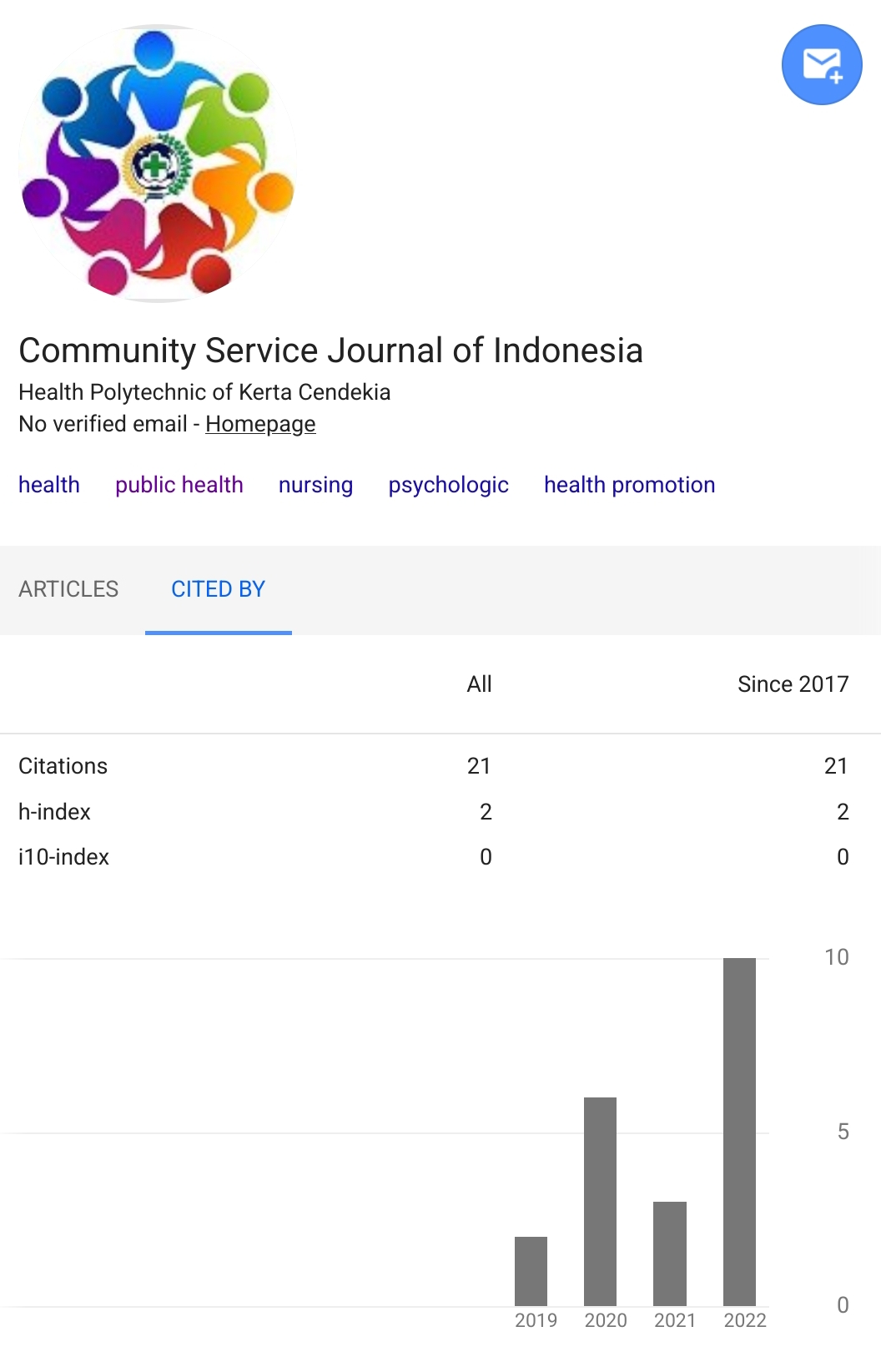YOUTH NUTRITION EDUCATION FOR FEMALE STUDENTS
Abstrak
Adolescence is characterized by a phase of rapid growth and development in which the need for nutrients and micronutrients is relatively high. Adolescents with good nutritional knowledge are more likely to follow healthy eating habits. In this regard, this community service is planned to assess basic knowledge related to nutrition for adolescent girls in increasing their knowledge related to nutrition. Main Activities Educational activities on adolescent nutrition, the target is young female students of the Salafiyah Syafi'iyah Sukorejo Islamic Boarding School, located on the Faculty of Health Sciences Campus. The purpose of the implementation is to increase the insight of young women about balanced nutrition in adolescents . The conclusion of this activity is that most of the young female students have not implemented a healthy lifestyle in their daily life, most of the nutritional status of the female students are normal nutrition, most of the teenage studentsReferensi
Alam, N., Roy, S. K., Ahmed, T., & Ahmed, A. M. S. (2010). Nutritional status, dietary intake, and relevant knowledge of adolescent girls in rural Bangladesh. Journal of Health, Population and Nutrition, 28(1), 86–94. https://doi.org/10.3329/jhpn.v28i1.4527 DOI: https://doi.org/10.3329/jhpn.v28i1.4527
Depkes. (2013). Pedoman Umum Gizi Seimbang.
Depkes. (2016). Buku Saku Kesehatan Reproduksi Remaja (KRR) untuk usia 14-19 tahun.
Dewi Andariya Ningsih. (2015). Partnership Dalam Pelayanan Kebidanan. Proceeding Book.
Grosso, G., Mistretta, A., Turconi, G., Cena, H., Roggi, C., & Galvano, F. (2013). Nutrition knowledge and other determinants of food intake and lifestyle habits in children and young adolescents living in a rural area of Sicily, South Italy. Public Health Nutrition, 16(10), 1827–1836. https://doi.org/10.1017/S1368980012003965 DOI: https://doi.org/10.1017/S1368980012003965
Heald, & EJ, G. (2011). Diet,Nutrition and adolescence. Dalam : Shills ME et al, penyunting Modern nutrition health and disease. Lippincott, Philadelphia.
Jaworska, N., & MacQueen, G. (2015). Adolescence as a unique developmental period. Journal of Psychiatry and Neuroscience, 40(5), 291–293. https://doi.org/10.1503/jpn.150268 DOI: https://doi.org/10.1503/jpn.150268
Kotecha, P., Patel, S., Baxi, R., Mazumdar, V., Shobha, M., Mehta, K., & Dkk. (n.d.). Pola diet remaja sekolah di perkotaan Baroda. India. J Kesehatan Popul Nutr.
Lembaga Ilmu Pengetahuan Indonesia. (2000). Widyakarya Nasional Pangan dan Gizi VI.
Neumark-Sztainer, D., Story, M., Falkner, N. H., Beuhring, T., & Resnick, M. D. (1999). Sociodemographic and personal characteristics of adolescents engaged in weight loss and weight/muscle gain behaviors: Who is doing what? Prev Med, 28, 40‑50. https://experts.umn.edu/en/publications/sociodemographic-and-personal-characteristics-of-adolescents-enga DOI: https://doi.org/10.1006/pmed.1998.0373
Ningsih, D. A. (2017). Continuity of Care Kebidanan. OKSITOSIN : Jurnal Ilmiah Kebidanan, 4(2), 67–77. https://doi.org/10.35316/oksitosin.v4i2.362 DOI: https://doi.org/10.35316/oksitosin.v4i2.362
Ningsih, D. A. (2021). Midwifery Women Center Care Pada Masa Nifas dalam Buku Asuhan Kebidanan Pada Masa Pandemi Covid-19 (P. Qorinah Estiningtyas Sakilah Adnani, M.Keb & D. R. Pangestuti (Eds.)). CV Penulis Cerdas Indonesia. https://drive.google.com/file/d/18SXFDo5VC58S6HNoVTghykHXh8dHROQN/view?usp=sharing
Organisasi Kesehatan Dunia, K. R. untuk A. T. (n.d.). Kesehatan dan Perkembangan Anak dan Remaja: Gizi Remaja tersedia dari: http://www.searo.who.int/entity/anak_remaja/topik/nutrisi/nutrisi/en/(Terakhir diakses pada 10 April 2020).
PDGMI. (n.d.). Perhimpunan Dokter Gizi Medik Indonesia (PDGMI) dan Perhimpunan Dokter Spesialis Gizi Klinik Indonesia (PDGKI) Buku saku gizi seimbang bagi remaja. In 2010.
Ponpes Sukorejo. Pondok Pesantren Salafiyah Syafiiyah Sukorejo Situbondo. (n.d.).
Sawyer, S. M., Afifi, R. A., Bearinger, L. H., Blakemore, S.-J., Dick, B., Ezeh, A. C., & Patton, G. C. (2012). Adolescence: a foundation for future health. Lancet. DOI: https://doi.org/10.1016/S0140-6736(12)60072-5
Shah, P., Misra, A., Gupta, N., Hazra, D. K., Gupta, R., Seth, P., Agarwal, A., Gupta, A. K., Jain, A., Kulshreshta, A., Hazra, N., Khanna, P., Gangwar, P. K., Bansal, S., Tallikoti, P., Mohan, I., Bhargava, R., Sharma, R., Gulati, S., … Goel, K. (2010). Improvement in nutrition-related knowledge and behaviour of urban Asian Indian school children: findings from the ‘Medical education for children/Adolescents for Realistic prevention of obesity and diabetes and for healthy aGeing’ (MARG) intervention stud. British Journal of Nutrition, 104(3). DOI: https://doi.org/10.1017/S0007114510000681
SINGH, A., GROVER, K., & SHARMA, N. (2014). Effectiveness of nutrition intervention to overcome the problem of anaemia. Food Science Research Journal, 5(2), 184–189. https://doi.org/10.15740/has/fsrj/5.2/184-189 DOI: https://doi.org/10.15740/HAS/FSRJ/5.2/184-189
Theresa A. Nicklas. (2002). Calcium Intake Trends and Health Consequences from Childhood through Adulthood. Journal of the American College of Nutrition, 22(5). DOI: https://doi.org/10.1080/07315724.2003.10719317
Tramontana, M. G. (2013). The Adolescent Brain. Cognitive and Behavioral Neurology, 26(2), 100–101. https://doi.org/10.1097/wnn.0b013e318294860b DOI: https://doi.org/10.1097/WNN.0b013e318294860b
##submission.copyrightStatement##
##submission.license.cc.by-nc4.footer##Authors who publish with Community Service Journal of Indonesia agree to the following terms:
- Authors retain copyright licensed under a Creative Commons Attribution-NonCommercial 4.0 (CC BY-NC 4.0), which allows others to remix, tweak, and build upon the authors' work non-commercially, and although the others' new works must also acknowledge the authors and be non-commercial, they don't have to license their derivative works on the same terms.
- Authors are permitted and encouraged to post their work online (e.g., in institutional repositories or on their website) prior to and during the submission process, as it can lead to productive exchanges, as well as earlier and greater citation of published work (See The Effect of Open Access). Authors can archive pre-print and post-print or publisher's version/PDF.













